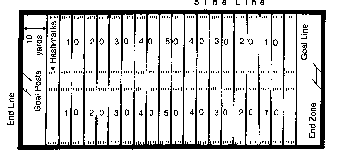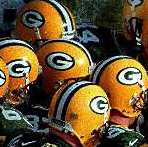
THE PLAYING FIELD
The football playing field is rectangular, measuring 100 yds long
and 53 1/3 yds wide. A rather strange dimension which is another story (but
had something to do with the width of the Harvard University field which
was the largest park around at that time.)

The goal lines at both ends of the 100-yard dimension, mark the
entrances to the 10-yd 'end zones'. Each team defends an 'end zone'. Essentially
the object of the game score more points than the other team by either running
or passing the ball into the opponent's end zone to score a 'touchdown'.
Lines parallel to the end zones cross the field at 5-yd intervals.
These lines give the field a resemblance to a large gridiron, hence the name.
Another set of lines, known as the sidelines, runs along both
sides of the field. In addition, two rows of lines, called hash marks, run
up the middle of the field parallel to the sidelines. The hash marks are
70'9" from each sideline. Each play begins with the officials placing the
ball either on or between these hash marks, closest to the end of the previous
play (i.e. either left or right).
Situated in the middle of the end zone at either end are goalposts,
consisting of a 10' vertical pole topped by a horizontal crossbar from which
two vertical upright posts rise, they are 18'6" apart.

SCORING

A Touchdown is worth 6 (six) points. The ball is either carried
over the line or passed to a player in the endzone. In passing situations,
the receiving player must be inbounds with both feet after coming down with
the catch, otherwise the play is called back.
After the Touchdown, a team attempts a conversion on the next
play. There are two options. The place kick option worth 1 (one point)
is the most common. That is the kicker comes on to boot the ball through
the goal posts. (In 1998, teams had 98.3% success rate at extra point attempts).
The '2 point conversion' option is basically another attempt to get the ball
into the end zone from a set play staring at the 2 yard line. Only one attempt
is available with this option.
Teams may also score points by field goals worth 3 (three) points.
A field goal is scored by means of a place-kick, in which one player holds
the ball upright on the ground for the kicker to try and kick between the
uprights and over the crossbar.
After each field goal and extra-point conversion, the scoring
team must kick off to its opponents from the half way mark.
Teams can also score points defensively. That is if the offense
is tackled with the ball in it's own end zone the defending team scores a
'safety' which is worth 2 (two) points.

PLAYING TIME
A game of football consists of 60 minutes of playing time. These
are further divided into 2 - 30min halves and 4 - 15 minute 'quarters'. There
are two clocks used in the game. One is the 'gameclock', which is basically
the time elapsed in a particular quarter, the other is the 'playclock'.
The playclock is reset to 00:00 after each play, and the next play must resume
within 40 seconds otherwise the team in possession of the ball is penalized.
The gameclock stops after the end of each quarter, or whenever the referees
signal for stopage after certain plays. A '2 minute warning' is signalled
before the end of each half. Tactically this is an important moment in any
game, allowing teams to get together for a considerable period of time to
assess the situation and act accordingly.

THE GAME ITSELF 
Before the game begins, the referee calls up the captains of the
two teams for a coin toss. This coin toss determines which team will kick
and which one will receive the ball.
The game starts with the special teams on the field ready for
the kickoff. The ball is placed kicked from a tee. The kicking team lines
up at or behind the ball, while the opponents spread out over their territory
in a formation calculated to help them to catch the ball and run it back
effectively. The kicker kicks off the game by kicking the ball, which is
caught by the kick returner (KR) of the opposing team. The KR tries his best
to return the ball down the field, into the other team's half of the field
and all the way into the endzone, but this happens very seldom, and usually
the returner is tackled inside his own half of the field. Wherever the ball
carrier is brought down is the line of scrimmage, that is the position from
where the team's offense will take control of the ball. If the ball is kicked
out of the endzone, the result is a 'TouchBack'
and the team starts from
its own 20 yd line.
When the offense of one team comes out on the field, the opposing
defense is ready to try and stop them. The offense gets a set of four plays
or 'downs' to cover a distance of at least 10 yards from the line of scrimmage.
This can be done by either running or passing the ball. A play begins when
the center snaps the ball from in between his legs to the quarterback, who
goes back a few yards and either hand the ball to the running back or keeps
the ball and runs himself or
more often passes it to any open wide receiver.
If the team attempts a running play, the running back takes the
'hand-off' from the quarterback and tries to run it upfield. Meanwhile, the
offensive line is battling with the defensive line of the other team to pave
a way or create a 'hole' in the defensive line for the running back to hit.
Once the running back hits the hole, there is a good chance that he could
go all the way for a score. But this usually isn't the case, the running-back
is tackled or 'downed', and that's where the next play will begin. If a running
back, quarterback, or any wide receiver drops (fumbles) the ball, and if
it is picked up by a member of the defense, then the ball is turned over.
Turn Overs play a big role in games, and very often shift the momentum of
the games. Another type of a Turnover is the Interception, which is explained
in the next few lines.

On the other hand, if the team is attempting a passing play, the
quarterback, after taking the snap from the center, keeps the ball himself,
goes back to where he could get a clear view of the playing field and the
players, and passes the ball out to an open wide receiver, who is actuyally
being covered by a defensive back. If the player is unable to catch it while
in bounds (this term is used when the player is actually inside the playing
are of the field and has not stepped out of the sidelines), the pass is said
to be 'incomplete', the ball is kept back to where it was, and the clock
stops until the next play resumes. If a wide reciever is unable to catch
the ball and the ball is caught by a a member of the defense, the ball is
said to have been intercepted. After having intercepted the ball, a player
can run the other way for a score.
After each play, the teams get into a 'huddle' (gathers in a circle)
to decide what play to call next. In the same way, the offense keeps on attempting
each play, until there is a stage where they have not covered atleast 10 yds
in 3 plays. When this happens, a team usually kicks (or 'punts') the ball
away to the opponents, who have a returner positioned, waiting to catch the
ball and return it as far down the field as possible. In punting, the kicker
drops the ball and kicks it before it touches the ground. By punting, a team
can send the ball farther away from its own end zone before surrendering
it, thus weakening the opponent's field position.
However, if a team is in desperate need of points, it will attempt
a 4th down play. If it is successful, then they are awarded with a fresh
set of downs, otherwise possession shifts to the other team from where they
left. A team may also select to attempt a field goal on 4th down.

THE EQUIPMENT

The players wear special equipment during the game to try and
lessen the impact of being hit by a 'freight train'.This includes lightweight
plasticized padding covering for the thighs, hips, shoulders, knees, and
somtimes the forearms and hands. Players also wear plastic helmets with guards
that cover most of the face. Some of these helmets, esp. those of the quarterbacks,
have a built-in headset, which allows communication between the on-field player
and the assistant coaches and/or the head coach.
The football consists of an inflated rubber bladder encased in
a leather or rubber cover. The ball is an extended spheroid, having a circumference
of 28.5 in (72.4 cm) around the long axis and 21.25 in (54 cm) around the
short axis. It weighs between 14 and 15 oz (397 and 425 g).

THE TEAMS OF THE NFL
The teams are divided into eight different divisions and two conferences.

AFC (American Football Conference)
